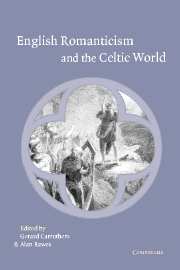Book contents
- Frontmatter
- Contents
- List of contributors
- Acknowledgements
- 1 Introduction: romancing the Celt
- 2 Sir William Jones, the Celtic Revival and the Oriental Renaissance
- 3 The critical response to Ossian's Romantic bequest
- 4 Blake and Gwendolen: territory, periphery and the proper name
- 5 The Welsh American dream: Iolo Morganwg, Robert Southey and the Madoc legend
- 6 Wordsworth, North Wales and the Celtic landscape
- 7 The force of ‘Celtic memories’ in Byron's thought
- 8 Shelley, Ireland and Romantic Orientalism
- 9 Byron and the ‘Ariosto of the North’
- 10 Scott and the British tourist
- 11 Felicia Hemans, Byronic cosmopolitanism and the ancient Welsh bards
- 12 Luttrell of Arran and the Romantic invention of Ireland
- 13 Contemporary Northern Irish poets and Romantic poetry
- Notes
- Bibliography
- Index
4 - Blake and Gwendolen: territory, periphery and the proper name
Published online by Cambridge University Press: 22 September 2009
- Frontmatter
- Contents
- List of contributors
- Acknowledgements
- 1 Introduction: romancing the Celt
- 2 Sir William Jones, the Celtic Revival and the Oriental Renaissance
- 3 The critical response to Ossian's Romantic bequest
- 4 Blake and Gwendolen: territory, periphery and the proper name
- 5 The Welsh American dream: Iolo Morganwg, Robert Southey and the Madoc legend
- 6 Wordsworth, North Wales and the Celtic landscape
- 7 The force of ‘Celtic memories’ in Byron's thought
- 8 Shelley, Ireland and Romantic Orientalism
- 9 Byron and the ‘Ariosto of the North’
- 10 Scott and the British tourist
- 11 Felicia Hemans, Byronic cosmopolitanism and the ancient Welsh bards
- 12 Luttrell of Arran and the Romantic invention of Ireland
- 13 Contemporary Northern Irish poets and Romantic poetry
- Notes
- Bibliography
- Index
Summary
On the subject of Celts and the Celtic, Blake maintains a voluble reticence. That is to say, nowhere in his writings does he mention them by name; yet we know, from a whole panoply of intratextual and extratextual sources, of his close involvement with speculative antiquarianism, with the ‘matter of ancient Britain’, with the whole issue of historical explanation, especially as intertwined with a particular tradition of Biblical exegesis.
For example, there is throughout his work a continuing and evolving topos that links the history of Britain with the twelve tribes of Israel, making of Britain a nation that is at the same time an inalienable homeland and an unending diaspora, a foreign body in and to itself, an envelope for displacement that is at the same time a fons et origo, a partially obscured hieroglyph, the challenge of which for the interpreter is to restore it to its putative previous legibility. There is, to take a more specific example, the lost painting ‘The Ancient Britons’, the account of which in the exhibition advertisement of 1809 begins with a verse that has been shown to be a translation from the Welsh Trials:
In the last Battle that Arthur fought, the most Beautiful was one
That return'd, and the most Strong another: with them also return'd
The most Ugly, and no other beside return'd from the bloody Field.
- Type
- Chapter
- Information
- English Romanticism and the Celtic World , pp. 54 - 68Publisher: Cambridge University PressPrint publication year: 2003
- 1
- Cited by



